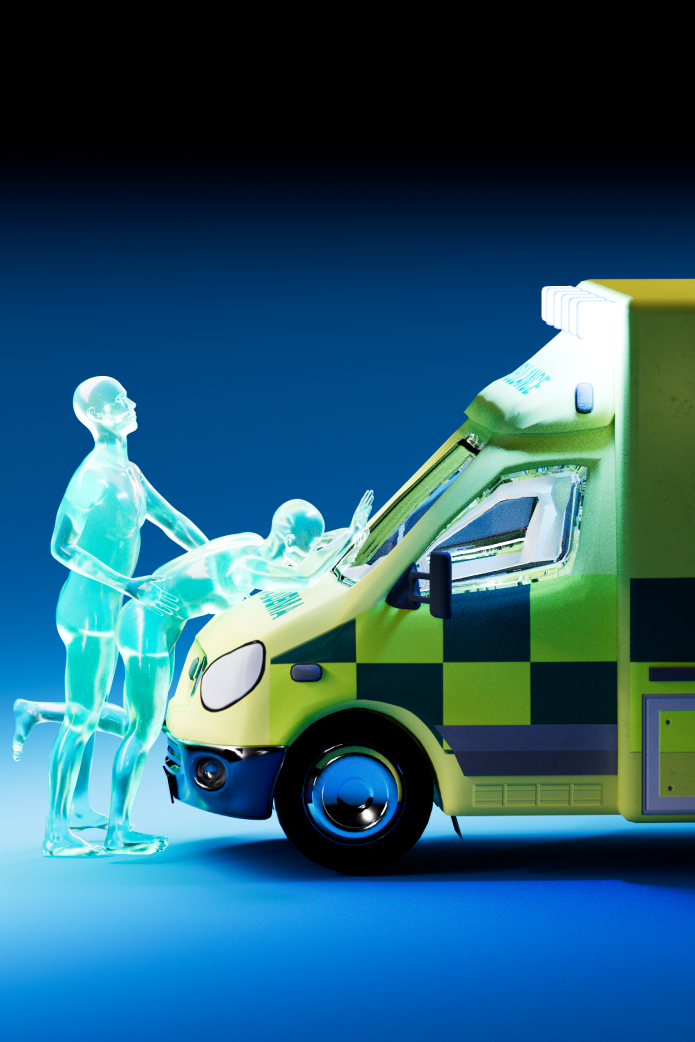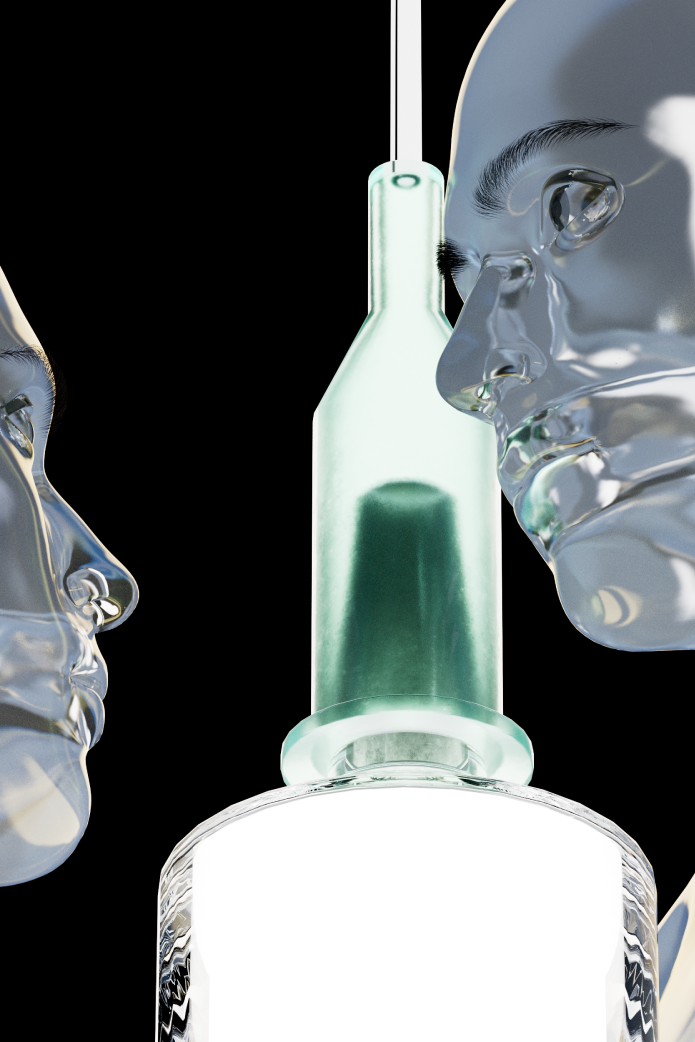
“Somebody overdoses, so they call for an ambulance, but the police turn up first,” Patriic Gayle says from across the table at the London HQ of the Gay Men’s Health Collective (GMHC), where he is Project Lead. We’re right next to stacks of condoms, lube, gloves, salt tablets and needles, neatly contained in cardboard packs. These boxes also come stuffed with educational pamphlets about everything from safe fisting to “your rights on arrest”. Gayle explains: “I’ve lost count of the number of times that gay men say, ‘Well, we know we should call for an ambulance. We don’t want anybody else to die. But we are afraid.’ And so they don’t. And I know of stories where guys have been put into Ubers and dropped off at A&E.”
It’s been 10 years since the term “chemsex” was first published, in a paper titled “Sexualised drug use by MSM (men who have sex with men”) and written by activist David Stuart. Since then, the “gay” scene and the chemsex scene has undergone changes. Salacious and borderline homophobic descriptions of chemsex played out in tabloid coverage of the 2016 trial of Stephen Port, who murdered four young men, likely with G/GHB/GBL, before finally being caught. In 2020, the same drug was reclassified to Class B – meaning higher sentences for possession and dealing – after rapist Reynhard Sinaga used it to facilitate his attacks on at least 48 men.
GAY TIMES analysis of government figures suggests that up to 1000 people have died from possible chemsex-related harms in the last decade, too. So what else is new for chemsex right now? What’s getting better? What still needs work? And as ever, how may homophobia play a part in how chemsex participants are treated?
“Chemsex is a very secretive world,” says Peter Kingsley. He’s an Advanced Paramedic for the London Ambulance Service (LAS), and along with Mental Health Consultant Nurse Carly Lynch and Mental Health Paramedic Lead Daniel Phillips, has identified two types of chemsex participants he’ll see on a callout. There are those “collapsed and fitting from a drug overdose” and those who have “absolutely destroyed themselves with problem drug use and are in a chronic addiction, drug-induced psychosis state.”
Due to the novelty of chemsex-associated drugs such as G/GHB/GBL, mephedrone and crystal methamphetamine, records of their consumption are patchy. The Office of National Statistics’ (ONS) yearly drug survey of adult users in England and Wales has estimated the use of substances like cocaine and cannabis since 2002. But records for mephedrone use – despite being used in the UK as early as 2003 – only began in 2009 (608,000 users, dropping to 541,000 in 2023). Same for records of crystal meth usage, which is only recorded as a sub-type of methamphetamine (292,000 users in 2009, dropping to 171,000 last year). These figures suggest that chemsex drugs are consumed less than 15 years ago, but the ONS only began recording G/GHB/GBL usage from last year (212,000 users). The data isn’t definitive, and so Kingsley tried to put another figure together.
He’s part of Project Sagamore, a multi-agency response to crime and vulnerability within the chemsex scene. It launched in February 2020, “off of the back of the horror that was the Port investigation,” Kingsley says. Initially, he worked out how many 999 ambulance calls in London were related to G/GHB/GBL, crystal meth, mephedrone or chemsex. And “if those keywords were in that initial phone call data, I could find them on the system.” This search found that on average, ambulances are called out to chemsex incidents once a day.
However, Kingsley cannot prove that the drugs mentioned in the call were actually taken. Nor can he prove “they’re taken in a chemsex context.” That could lower the true rate, but what may up it are the times bystanders will make a call about someone suffering chemsex-related harms without recognising they’re coming from a chemsex context: “It’s three o’clock on a Sunday morning in Vauxhall, and there’s a guy, late twenties, who’s semi-clothed in a distressed state and clearly intoxicated. You’ll recognise the toxidrome [symptoms of a toxin] and think, ‘Well, that looks a bit like crystal meth and GHB to me’ but you don’t know for sure.”
Kingsley has realised that trying to obtain accurate data on chemsex-related harms is “futile”, and so “we’ve deliberately held off from really getting too hung up on how big the problem is”. Instead, he’s seeking greater awareness of chemsex: “our rough data shows that about five hospitals receive around 50% of all the patients that we convey in the context of GHB/GBL and crystal meth”. So he works closely with those NHS Trusts to ensure that medics know how to identify and treat chemsex-related harms.
He’s keen to point out that this isn’t just about gay men; “We’re definitely seeing women who are affected.” And as Gayle puts it: “We’re proud of the fact that GMHC serves gay men, but on the other hand, we are very mindful that there are other letters to the spectrum, so increasingly, our work reflects that.”
As the gay scene has become more inclusive of the full LGBTQIA+ community, it follows that the chemsex scene has, too. Dee Dee, 36, is a pansexual sex worker based in Devon. “I help people party and I make sure everyone’s safe.” she says, explaining her own safety protocol of taste tests, never mixing G with alcohol “to stop you going under” and never accepting a drink from someone else.
Since her teens, her drug of choice has been crack, because “with a client it makes you dare to do stuff you wouldn’t normally do, it takes away all the fear”. However, “chemsex” is a new phrase for her: “I go to the clinic every six weeks and they’ve only just added ‘chemsex’ onto the questionnaire. I asked them what it meant, they said ‘sex with drugs’ and I said ‘well that’s normal, isn’t it?’”
“I just call it ‘partying’” she adds. But recently, the party turned sour after a client took multiple Viagra pills with cocaine despite her advising him not to. “He was tripping balls and his head went bright red. I figured ‘I’m not risking this shit’ so I had to call an ambulance.”
Though the queer scene has become more inclusive, its spaces have depleted. Even before the pandemic, the double-edged sword of gentrification and hook-up apps was slashing through prime gay bar real estate. “These places used to have staff, so you could engage with them on harm reduction, give them some training and they would at least be sober.” explains Kingsley, adding that he now attends “very few jobs in commercial premises”.


Gayle draws a line between the clubbing’s decline and a boost in chemsex harms: “20 years ago, there was this incredible symbiosis between clubs and people going to them. We’ve almost reached that tipping point now where even larger venues can struggle, there are less people using the scene.
“So you can do what you want in your own home and get everything delivered to your door. We all were told we’d be better connected on the phone. Now, most people would argue we’re potentially lonelier than we’ve ever been in our lives.” He has a similar opinion of at-home STI testing kits, arguing that while they are cost-efficient for the NHS, not everyone can use them effectively, “particularly if you don’t have the skills, the confidence, the mobility.” The lack of face-to-face interaction in a clinic, with all its awareness posters and outreach workers means “we run the risk of basically corrupting relationships that we’ve had between sexual health services and the LGBT community.”
Gayle warns: “We are cruising for a bruising, in terms of chemsex, the support that is available compared to the train that’s barreling down the track, it’s pitiful.”
London’s 56 Dean Street sexual health clinic is a world leader in its work. It’s been a decade since Stuart, who wrote that chemsex paper, pioneered a project there placing drug outreach within a sexual health context. The idea is to provide a specialised service with “the knowledge and skills… to discuss the issues relating to sex and the nuances of chemsex” because, as Stuart put it in 2015, many chems users “don’t perceive themselves as having a drugs problem and so would be unlikely to access a traditional treatment service.” His hope was to “create a model here that can be rolled out to other sexual health clinics”, he told VICE in 2015.
We are cruising for a bruising, in terms of chemsex, the support that is available compared to the train that’s barreling down the track, it’s pitiful
Stuart passed away suddenly in 2022, and two years to the day I’m on the phone to one of his former service users. “It’s amazing what he achieved,” says Darren Murphy. It was 2011 when Murphy first got into chems, and by 2014 he was diagnosed with HIV. Murphy only met with Stuart twice “because I was an absolute chaos at the time”, but it would have an eventual impact. In 2019 Murphy was imprisoned “because of chemsex-related crimes, selling crystal meth, mephedrone and GBL.” After moving back in with family in Leeds as part of his licence conditions, he discovered “there was no specific chemsex-oriented support, at all.”
Murphy is now a drug recovery coordinator at Forward Leeds, an alcohol and drugs organisation, and has begun the work of filling the “massive gap in chemsex support” by linking LGBTQIA+ organisations to provide holistic services to those suffering from chemsex-related harms.
And over in Merseyside, a former colleague of Stuart’s has set up a similar clinic. Chris Higgins, who worked with Stuart for over a decade at London Friend and Dean Street, has set up the Ctrl Alt Delete clinic with Axess Sexual Health clinic. However, “The landscape of drug use here in Liverpool is completely different.” Yes, some people use chemsex drugs, but the LGBT+ drugs scene in Liverpool centres on “cocaine, ecstasy, MDMA, ketamine and weed” and “a lot of the referrals when I first opened the clinic were for alcohol”. Higgins’ theory is that “Liverpool just hasn’t had that same environment for chemsex drugs to blossom”, because it’s never had “licensed sex on premises venues, no saunas, no bathhouses… So if chemsex is taking place, it’s in people’s homes, not in public places”. In Manchester, its Reach Clinic is for people who would like support to manage or reduce their use of chems, and operates out of The Northern Contraception and Sexual Health and HIV Service.
GAY TIMES contacted NHS Trusts covering other areas with large LGBTQIA+ populations such as Newcastle, Bristol and Cardiff to ask if they have services with drug harm reduction working within sexual health clinics. None did, although each made clear that if someone presents at a sexual health clinic with drug concerns, they will be triaged to these services. As for Brighton, its sexual health service staff have all received training in identifying patients who may need chemsex support.
A spokesperson for The Department of Health told GAY TIMES: “The government is aware of the harms caused by chemsex and has issued guidance to local authorities on managing this issue. We have allocated £532 million of funding to local authorities to reduce harm and improve recovery rates from drug addiction and to assist with rehabilitation… We continue to work with substance misuse commissioners and sexual health commissioners to improve access to support services for those who use drugs in a chemsex context.”
Chemsex-related harms may be, as Kingsley puts it, “niche” issues that are hard to secure funding for, but with fatality still a risk, it needs addressing. Analysis of ONS figures shows that hundreds have died from chemsex-related drugs. While 111 people have died in the past 10 years from a mephedrone overdose, 937 people have died from amphetamine overdoses. Disaggregation of the data to show crystal meth deaths started in 2018 and in the time between then and 2022, 113 died of crystal meth overdose. 238 people died from G/GHB/GBL overdoses in the past ten years. Even a conservative estimate shows that almost 500 people have died from chemsex-associated drugs in the past decade.
This could be an overestimate; people may have not been taking these drugs in a chemsex context. However, it could also be an underestimate; G/GHB/GBL is not routinely tested for in toxicology reports, and this must be requested for by the bereaved. And in cases where multiple drugs were present, as there were for a fifth of drug-related deaths in 2019, any drugs in the deceased’s system is not named in coroner’s reports, rather the cause of death listed as “multiple drug toxicity” or “drug overdose”.
Campaigners also warn of seizures and fits, the risk of contracting new STIs, especially HIV and Hepatitis C, which needle users are at higher risk of, as well as addiction. Consent is also an issue that needs more awareness, experts agree, with Kingsley explaining: “If you take disinhibiting drugs, the blurring of the lines around consent is enormous, isn’t it?”
If you take disinhibiting drugs, the blurring of the lines around consent is enormous, isn’t it?
Chemsex is a public health issue for many queer people, however, it is also treated as a criminal justice issue, with police allegedly turning up instead of the ambulances that have been called. Chemsex participants live in fear of this happening, with Kingsley citing a callout where “somebody had phoned for a collapse from a crystal meth overdose. And when the crew arrived, the front door to the property was open. Everybody else had left, lying him on his side in a sort of recovery position and unconscious, with a blanket over him.” Murphy’s also heard of people “going under” and then “just getting put outside the house. [The people in the house] didn’t want any ambulance coming, or the police coming, because there were a lot of substances in the house, people were scared to get arrested.”
The Metropolitan Police was approached for comment on allegations in this article that they have attended incidents where the 999 caller requested an ambulance, however without specific times and dates of the calls, they cannot respond.
For their part, Kingsley, Lynch, Phillips, and Gayle have collaborated to create discreet cards to be handed out at chemsex sessions gone wrong. Just as someone is stretchered off is a “reachable moment” for the rest of the room, Kingsley says. So partiers aren’t admonished, rather given useful information via a QR code that pulls through to www.stuffyoucantunsee.co.uk, by crew who have been trained by Lynch on Phillips on how to approach those affected by chemsex harms, including overdoses and drug-induced psychosis.
No other UK ambulance service does this work, but there’s hope that, just like Stuart’s work to connect drug outreach services with sexual health clinics, green shoots will begin to grow. With the closure of so many LGBTQIA+ venues, increased risk of criminal convictions for those dealing G and an increased bifurcation of the LGBTQIA+ community to those who fall in step, socially, with their straight peers, and those who live genuinely alternative lifestyles, it would be no wonder if secrecy around chemsex has intensified. However, this, even more so than seemingly basic metrics like drug consumption and death rates, is hard to measure.
It’s staggering to me the amount of people that are not getting themselves checked, and not asking for other people’s statuses when they go in to willingly have unprotected sex – not just HIV, but Hep C too
But the solutions to chemsex-related harms remain the same; the biggest risk of all seems to be not just in the sex or the drugs or the heady, horny combination of both, but ignorance. In any drug-taking scene there is an element of gatekeeping, of not wanting to ask simple questions for fear of either seeming naive or for saying out loud what’s apparently cooler to keep quiet.
As Murphy puts it: “It’s staggering to me the amount of people that are not getting themselves checked, and not asking for other people’s statuses when they go in to willingly have unprotected sex – not just HIV, but Hep C too.” He advises care and to “get in there first” with the question “before you actually meet, ask them ‘What is your status? And when did you last get tested?’”.
Other broad things to be aware of, the experts agree, are your feelings ahead of a session, the drinks and doses you have while there – one person’s small dose of G is another person’s trip to A&E – and your own limits, as well as your exit plan.
State-funded help for chemsex isn’t perhaps where David Stuart dreamed it would be, and any attempts to criminalise chemsex users rather than assist those struggling with chemsex harms seem dystopic. But there is help out there, there are people who will answer your questions, and wherever you are on your journey, you have choices.



